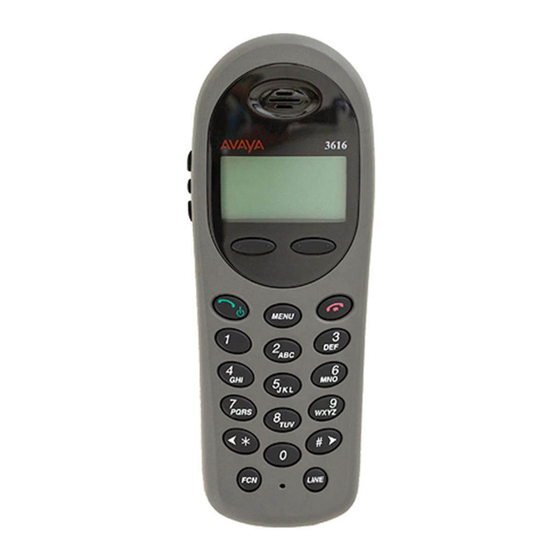Avaya 3620 Series Instrukcja instalacji - Strona 9
Przeglądaj online lub pobierz pdf Instrukcja instalacji dla Telefon Avaya 3620 Series. Avaya 3620 Series 19 stron. Wireless telephones
Również dla Avaya 3620 Series: Skrócona instrukcja obsługi (2 strony)

Installation Guide
the maximum recommended bandwidth usage by the percentage of bandwidth used for each
individual call. Note that approximately 20 to 40 percent of the AP bandwidth must be reserved for
channel negotiation and association algorithms, occasional retries, and the possibility of occasional
transmission rate reductions caused by interference or other factors. Therefore, 65 to 80 percent of the
total available bandwidth should be used for calculating the maximum call capacity per AP. For
example, if all calls on an AP are using a theoretical 5.4 percent of the bandwidth at 11 Mb/s, the
actual number of calls expected at that rate would be about 12 (65 percent of bandwidth available / 5.4
percent theoretical bandwidth utilized per call). Lower overall bandwidth is available when there are a
greater number of devices associated with an AP.
2.4 Capacity
Network capacity requirements factor into the number of APs required, although in most cases the
coverage area is the primary factor. Data traffic is often very bursty and sporadic. This is typically
acceptable because data applications can tolerate network congestion with reduced throughput and
slower response times. Voice traffic cannot tolerate unpredictable delays, where the bandwidth
requirements are much more constant and consistent. Voice traffic can also be predicted using
probabilistic usage models, allowing a network to be designed with high confidence in meeting
anticipated voice capacity requirements. Beyond the standard IP telephony design guidelines, there
are several additional considerations that should be addressed for Wi-Fi telephony with Avaya
wireless telephones.
To prevent oversubscription of an AP, and to ensure effective load balancing, the maximum number of
active calls per AP is configured in the Avaya Voice Priority Processor (AVPP.) Recommended
settings are AP specific and can be found in the individual Configuration and Deployment Guides
found on the Polycom web site. For Avaya 3641 and 3645 handset deployments, the maximum
number of active calls must be defined individually for each of the three possible radio types –
802.11b, 802.11g and 802.11a. Although 802.11g and 802.11a networks theoretically provide
increased available bandwidth for support of additional simultaneous call volume, the practical call
volume limitations will depend on many factors such as data rates used, competing network traffic and
network performance.
2.41 Access Point Bandwidth Considerations
There are several factors which determine the AP bandwidth utilization during a telephone call. The
first is the VoIP protocol used and its characteristics. The type of codec utilized combined with the
packet rate will determine the size of the voice packets along with any additional overhead information
required for the protocol. Payload data will generally account for 30-50%of a typical voice packet, with
802.11 and IP protocol overhead filling the rest. The 802.11 protocols include timing gaps for collision
avoidance, which means bandwidth utilization is more accurately quantified as a percentage of
available throughput rather than actual data throughput.
The percentage of bandwidth required is more for lower data rates; however it is not a linear function
because of the bandwidth consumed by the timing gaps and overhead. For example, a call using
standard 64 kb/s voice encoding (G.711) utilizes about 4.5 percent of the AP bandwidth at 11 Mb/s,
and about 12 percent at 2 Mb/s. In this example, four simultaneous calls on an AP would consume
about 18 percent of the available bandwidth at 11 Mb/s or about 48 percent at 2 Mb/s.
The maximum number of simultaneous telephone calls an AP can support is determined by dividing
the maximum recommended bandwidth usage by the percentage of bandwidth used for each
individual call. Note that approximately 20 to 40 percent of the AP bandwidth must be reserved for
channel negotiation and association algorithms, occasional retries, and the possibility of occasional
transmission rate reductions caused by interference or other factors. Therefore, 65 to 80 percent of the
total available bandwidth should be used for calculating the maximum call capacity per AP. For
example, if all calls on an AP are using a theoretical 5.4 percent of the bandwidth at 11 Mb/s, the
actual number of calls expected at that rate would be about 12 (65 percent of bandwidth available / 5.4
Octiober 2008
9
